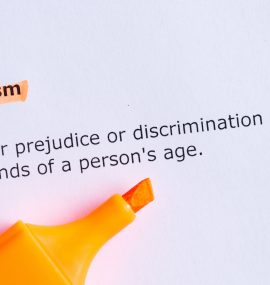Pervasive, socially acceptable, negative age-stereotypes
Ageism can be countered
Ageism refers to stereotypes, prejudice, and discrimination against people based on their age. Unlike racial or sexual stereotypes that people typically frown upon, ageism is socially condoned and institutionalized in the US. The combination of negative age-related stereotypes and discrimination can make ageism a chronic stressor for older people.
Becca Levy, a Yale University psychologist who has studied aging for two decades, developed the concept of stereotype embodiment. According to Levy, stereotypes from the surrounding culture become embodied when individuals accept the stereotypes as self-defining. The stereotypes related to ageism are generally negative. Those self-definitions influence life functioning and health. Thus, over the course of their lives, older people may embody negative age-stereotypes, often unconsciously. An example: Getting older inevitably leads to being sedentary, frail, and mentally deficient. The embodied negative age-stereotypes create chronic stress, which leads to greater risk of chronic diseases.
Interventions have been developed to counter ageism, but their effectiveness has not been evaluated until now. Researchers from Canada and the US conducted a systematic review and meta-analysis of published intervention studies. Sixty-three studies qualified for the meta-analysis. Most of the participants in the interventions were young (mean age of 22 years). The outcomes that researchers evaluated included attitudes toward aging, knowledge of aging, comfort with older adults, anxiety about one’s own aging, and working with older adults. Ageism interventions showed a strong, significant effect on attitudes, knowledge, and comfort, but not on anxiety or working with older adults. Interventions that include education and inter-generational contact produced the largest effects. Thus, interventions targeted toward younger persons may help reduce the negative effects of ageism on older persons.
Becca Levy proposes a different, two-tiered approach to countering ageism. The top-down part would include a White House-level “aging czar”, along the lines of the “drug czar.” The aging czar would coordinate policy initiatives on the federal level. The bottom-up part would entail building a grassroots social movement, along the lines of the feminist and civil rights movements. “Cognitive liberation” would be key aspect of the social movement. People would shift their beliefs and attitudes from accepting ageism-related stigmas to rejecting them. Those of us who are older can take the lead by culling age-related stereotypes from our minds and replacing them with beliefs that support successful aging. We can remind others when they use ageist language. Levy’s research highlights the benefits you can enjoy from recognizing the pervasive, negative old-age stereotypes in American culture and taking steps to change your mind about growing older.








